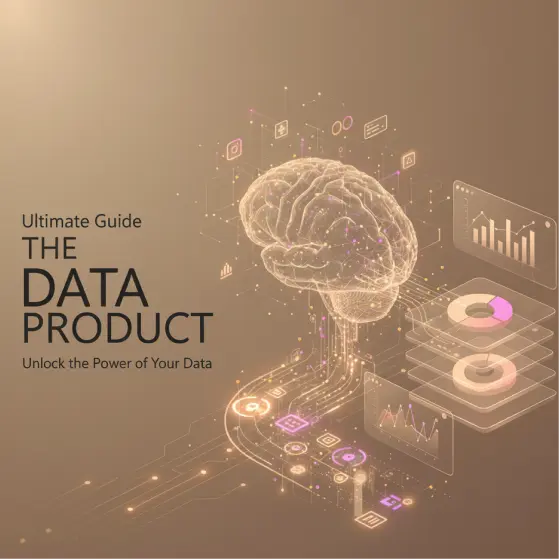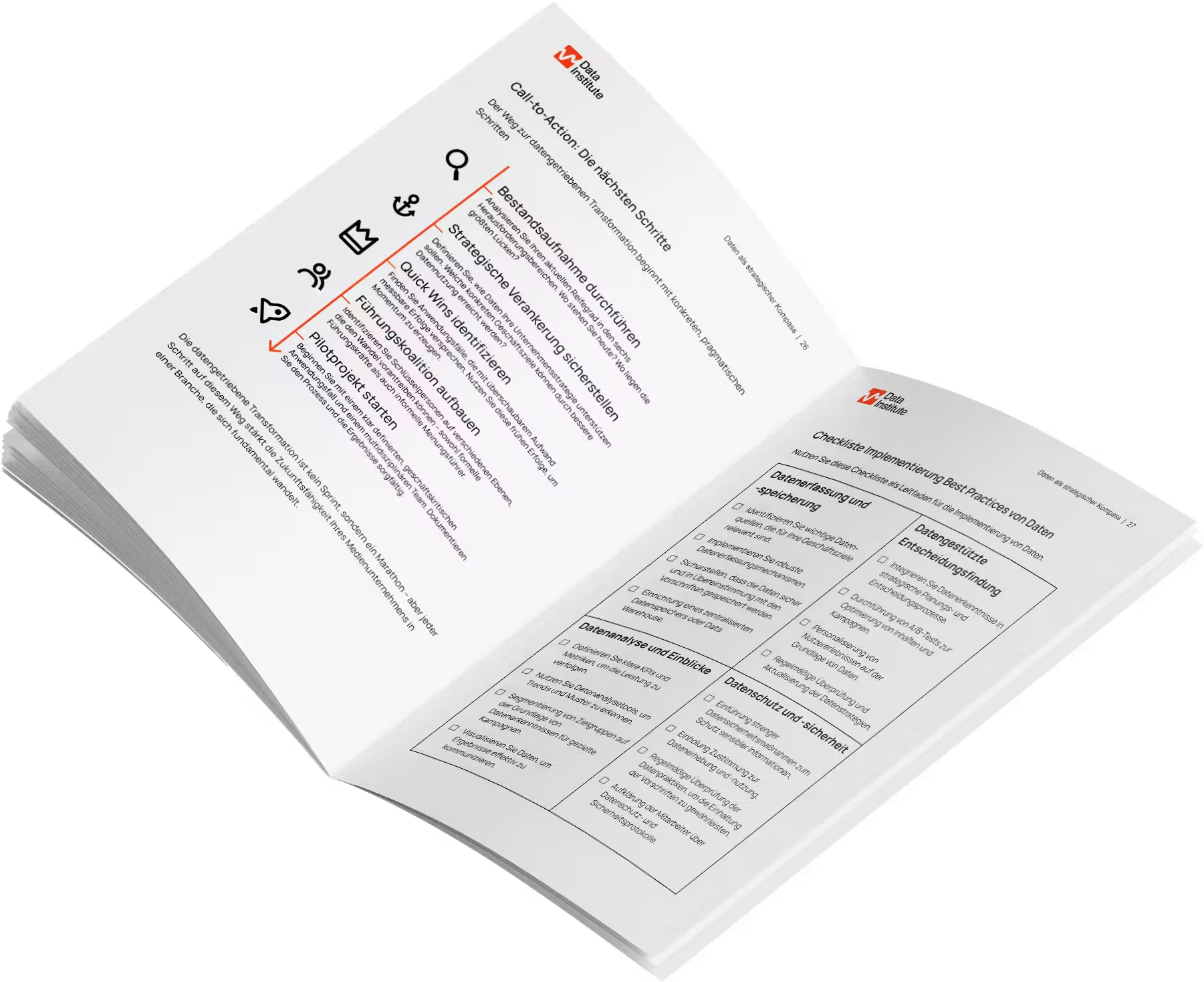The ultimate guide to the data product


The roadmap for data-driven transformation
The ePaper shows you strategies, success stories and a checklist for a direct start into the digital future.

- Das ist eine H2
- Das ist eine H3
The Shift to a Data Product Strategy
Sound familiar?
Your company invests millions in data infrastructure. New tools. Cloud migration. A data team that keeps growing. Yet your analysts still spend half their time consolidating Excel spreadsheets.
It's not a technology problem.
Here's what we see in most companies: Central BI projects become bottlenecks. Data is fragmented—we call it the "Excel Knight" phenomenon. Different systems show different numbers, leading to endless debates. Nobody really trusts the data. The result? Shadow IT. Data hoarding. Every department creates its own version of truth because the centrally provided data simply doesn't fit their needs.
The solution isn't more technology. It's a fundamental shift in how you think about data.
At The Data Institute, we've learned one thing across dozens of transformation projects: Successful companies treat data as a product. Not as an IT project. Not as a byproduct. As a standalone product with an owner, a roadmap, and measurable business value. And they shift responsibility to where the expertise lives—to the domain experts.
Our holistic approach (the TDI Framework): Success doesn't rest on a single pillar. You need all three—the right organization (clear roles and responsibilities), the right culture (willingness to change, data literacy), and solid architecture (automated processes, self-service capabilities).
This guide shows you how to design, develop, and manage data products to:
- Solve your scaling problems—technical and organizational
- Create a Single Source of Truth (SSOT) within each domain
- Transform the controller's role—from data gatherer to strategic business partner
- Generate competitive advantages through targeted use of your data assets
- Build a scalable, trustworthy data ecosystem—regardless of which technology trends come and go
Lay the foundation for a scalable, trustworthy data ecosystem—regardless of which technology trends are currently in vogue.
---
Part 1: The Basics — What Is a Data Product Really?
The Precise Definition (And Why It's Not Just Another Dashboard)
What is a data product?
Think of Netflix as a data organization. Their recommendation engine isn't a dashboard someone built once and forgot about. It's a service. With SLAs. With a team responsible for it. With millions of users who rely on it working—every single time.
That's a data product.
A data product is far more than a dashboard or Excel file. It's a strategically designed digital asset that does three things:
1. Delivers defined business value and solves a specific problem (customer segmentation, fraud detection, optimized pricing)
2. Is actively managed—with a roadmap, support, and Service Level Agreements (SLAs)
3. Abstracts complexity and provides data through clear service interfaces (APIs)
The Critical Distinction
A simple report is the result of an ad-hoc request. You ask, someone delivers. Done.
A data product is an independent service that's reusable and carries ongoing content responsibility (domain ownership).
That dashboard you see? That's often just the tip of the iceberg—the user interface. The actual data product includes the entire pipeline behind it: quality assurance, governance, documentation.
The Three Core Properties
How do you recognize a good data product? By three characteristics—the third is often underestimated:
1. Addressability — I can find it
2. Consumability — I can use it (without asking anyone)
3. Value Proposition — I know what it's good for
Why Data Products Are Now Critical
Data products are the cornerstone of modern data strategy. Why now? Because the biggest scaling problem isn't technology—it's dependency on central teams.
The Shift to Decentralized Strategies and Domain Ownership
As long as your central BI department is the bottleneck, you won't scale. Period.
The solution? Shift responsibility for data quality and business value to the domain experts. The marketing department knows marketing data best. Finance knows financial data best. Let them own it.
Data Democratization — Finally a Reality
Data products make it possible to abstract complex data from the architecture and provide it to end users as a simple, reliable service.
The controller no longer needs to understand how the data pipeline works. They just need to know: "I need sales figures by region"—and get them. Reliably. Up-to-date. Accurately.
This transforms the controller's role from data gatherer to strategic business partner. Instead of copy-paste, they do analysis—based on numbers they trust.
Examples of Data Products in Practice
Abstract definitions are nice. But what does this look like in reality? Here are real use cases from various industries:
E-Commerce: Customer LTV Feature Set (API)
The problem? Optimize ad spend, but no idea which customers are actually valuable.
The solution: A data product that provides machine-generated Lifetime Value (LTV) scores for every customer in real-time—directly for bid optimization in Google Ads.
Result: Higher conversion rates at lower costs.
Media/Publishing: SSOT Advertising Sales Dataset (Table/View)
The problem at MediaPrint? Fragmented measurement of ad inventory. Revenue figures from print, digital, events—all in different systems with different definitions. Endless debates: "Which number is correct?"
Our solution: We built a consolidated, cleansed dataset of all revenue and impressions from various systems—a Single Source of Truth (SSOT).
The result? 87% reduction in manual reporting effort. Manual processing became completely obsolete, and the origin of the data is secured, creating trust. → Read the MediaPrint case study
Would you like to check whether your organization is ready to introduce data products? Let us talk without obligation and book an appointment.
Now that you understand what data products are and why they matter, let's dive into how to actually build them systematically
---
Part 2: The Data Product Lifecycle (Lifecycle Management)
Here's the hard truth: Most data products don't fail because of bad ideas. They fail in execution.
I've seen it too many times. A team has a brilliant vision for a data product. Three months later, it's a half-finished dashboard nobody uses. Why? Because there was no structured process. No clear ownership. No maintenance. No real product mindset.
Successful data product implementation requires a structured, repeatable process. The data product lifecycle ensures that data products are treated like mature software products: with continuous improvement, strict quality standards, and integrated governance.
This lifecycle is the operational anchoring of the architecture pillar in our TDI Framework. It combines technical excellence with organizational clarity and cultural responsibility.
The 5-phase life cycle at a glance
Phase 1: Discovery and Design — The Strategic Starting Point
Without a clear concept, data initiatives fizzle out. Every time.
This phase isn't about technology. It's about strategy. You must answer five key questions before even one line of code is written:
1. Which specific business problem does the data product solve?
Not "we want to be data-driven." Instead: "Our sales team loses 10 hours per week on manual lead qualification." Specific. Measurable. Painful.
2. Who is the target audience?
"Everyone" is not an answer. Who are the primary users? The sales manager? The marketing team? The CFO? Different users need different data products.
3. What measurable value is expected?
ROI. Time savings. Revenue increase. Cost reduction. Whatever it is—but measurable. "Better decisions" is too vague.
4. Which data sources are required and available?
Does the data even exist? Is it accessible? Is it high enough quality? Clarifying these questions early saves months of frustrating work.
5. What's the Minimum Viable Product (MVP)?
What's the bare minimum you can deliver within 1-3 months that creates real value? Not the luxury version with all features. The MVP.
MediaPrint Case Study: When we started at MediaPrint, we didn't jump straight into building. We conducted a comprehensive data audit. We identified fragmented data silos and prioritized use cases by greatest business potential. → MediaPrint Data Strategy Transformation
Phase 2: Design and Architecture — The Technical Blueprint
Now it gets technical. But careful: The biggest mistakes in this phase aren't technical—they're conceptual.
In this phase, you define the technical architecture that enables scalability and self-service. Four principles are critical:
1. API-First Design
Think about service interfaces from day one. REST APIs. GraphQL. Whatever fits your tech stack—but standardized. Documented. Versioned.
Why? Because a data product only accessible via dashboard isn't a real product. It's a report with fancy packaging.
2. Modularity
Build reusable data components. Customer segmentation logic you build correctly once and then use across three different data products? That's gold.
3. Scalable Data Pipelines
Cloud-native technologies that grow with increasing data volumes. What works with 100,000 rows today must also work with 10 million rows in a year.
4. Self-Service Capability
Intuitive documentation. Discovery mechanisms. Data catalogs. So users can consume the data product without IT tickets.
If your data product needs a 50-page user manual, you've lost.
Domain Ownership in Architecture: The architecture must support clear allocation of data responsibilities. Each data product is developed and operated within its domain—with clear Service Level Agreements (SLAs). Marketing builds marketing data products. Finance builds finance data products. Central IT provides the platform.
Phase 3: Development and Deployment — From Concept to Reality
The development phase transforms design into a productive data product. This is where the wheat separates from the chaff.
Automation is key here. Without automation, you don't have a data product. You have a maintenance monster.
CI/CD Pipelines for Data Products
Continuous Integration and Continuous Deployment are just as critical for data products as for software. Maybe more critical. They guarantee three things:
- Automated testing: Data quality checks, schema validation, performance testing. Every change is tested before going to production.
- Versioning: Traceable changes and rollback capability. You must be able to revert to the previous version within minutes if something goes wrong.
- Faster releases: Reducing time-to-market from months to weeks—or even days.
→ Read more in our deep-dive article: How we implement reliable CI/CD pipelines for data products—with specific implementation strategies and code examples.
Governance and Compliance by Design
This is where most companies make a fatal mistake. They build the data product first. Then—often months later—someone remembers: "Hey, what about GDPR?"
Too late.
Governance mechanisms must be automated already in Phase 3:
- Metadata management: Automatic cataloging in a data catalog. Each data product documents itself.
- Privacy tags: Classification of sensitive data (GDPR compliance). Personal data is automatically recognized and treated accordingly.
- Access control: Role-based permissions directly in the pipeline. Not as an afterthought.
Phase 4 & 5: Operations, Maintenance, and Scaling — The Continuous Lifecycle
A data product is never "finished." That's the fundamental difference from a report.
The operations and maintenance phase ensures long-term value creation. Three aspects are critical:
1. Monitoring and Observability
You need to know in real-time how your data product is performing:
- SLA monitoring: Timeliness, availability, latency. If you promise an SLA of "Data is max 1 hour old," you need to measure it. And trigger alarms when you break it.
- Error handling: Automatic notifications when pipeline failures occur. Not finding out only when an angry user calls.
- Usage tracking: Which users consume the data product? How often? Where do bottlenecks arise? This data is invaluable for continuous improvement.
2. Continuous Improvement
Based on user feedback and performance metrics, the data product is iteratively developed. The product roadmap of the Data Product Owner ensures the data product grows with business requirements.
Quarterly reviews. Prioritize new features. Deprecate old features nobody uses. That's product management—not IT operations.
3. Governance by Design — The Critical Differentiator
This is where the circle closes. If governance isn't automated and embedded in the lifecycle, it becomes a manual brake. Even worse—it's ignored.
Only by shifting responsibility to the domain (domain ownership) and its automated verification throughout the lifecycle do you ensure that flexibility and compliance go hand in hand.
Ready to launch your first data product lifecycle? Schedule a free 30-minute expert consultation and find out how we support you from discovery to scaling.
---
Part 3: Organization, Roles, and Domain Ownership
Let me start with an uncomfortable reality: Most data products don't fail because of technology. They fail because nobody is really responsible.
"Who's responsible for this dashboard?""Uh... the BI team?""And who on the BI team?""I'd have to check..."
That's not a data product. That's an orphan.
Successfully establishing data products is a core aspect of the TDI Framework in the organization pillar. The challenge of scaling is solved by shifting responsibility to domain experts (domain ownership)—and that's exactly where our core expertise lies.
Our experience: At The Data Institute, we systematically define, staff, and train these roles. In over 30 projects, we've seen how clear allocation of responsibilities transforms data usage from an IT project to a business-driven core competency. The difference is dramatic.
The Central Role in the Decentralized Model: The Data Product Owner (DPO)
Who is the Data Product Owner?
In short: The person you call at 3 AM when the data product is down.
Sounds harsh? It is. But it's precisely this clear responsibility that makes the difference between a genuine product and a neglected dashboard.
The Data Product Owner (DPO) carries overall strategic responsibility for the success and ROI of the data product. The DPO isn't the developer. Not the analyst. They're the product manager—the interface between business requirements and technical implementation.
What does a DPO actually do?
- Overall strategic responsibility for ROI and business success: If the data product doesn't deliver value, the DPO must answer for it. With numbers. With metrics.
- Development of the product roadmap: What gets built next? Which features have priority? The DPO makes decisions—based on business value.
- Stakeholder management and prioritization: Sales wants feature A. Marketing wants feature B. Finance wants feature C. The DPO must prioritize. And say "no" in the process.
- Definition of business value and KPIs: How do we measure success? Which metrics matter? The DPO defines that—not IT.
The Distinction: DPO vs. Analyst vs. Manager vs. Owner
A common misconception I see time and again: All these roles get lumped together. "They all do something with data, right?"
No. They don't.
The Key Difference Between DPO and Data Analyst:
The DPO defines what gets built. Strategy. Vision. Value proposition. "We need a data product that predicts our customer churn rate."
The analyst uses the finished product for insights and visualization. "The data shows that customers with more than three support tickets are 40% more likely to churn."
Both roles are critical. But they're fundamentally different.
Data Owner and Data Steward: Ownership and Quality Assurance
The clear separation between Data Owner (content accuracy) and Data Steward (operational governance) is crucial—and often misunderstood in practice.
Data Owner — The Content Expert
Typically a department head or domain expert. Not technical. But with deep business knowledge. The Data Owner is responsible for ensuring the data correctly represents business reality.
"Is this revenue figure correct? Does this customer segmentation reflect how we understand our business?"
The Data Owner gives final approval for productive use. Nothing goes live without their signature.
Data Steward — The Operational Quality Guardian
Typically a tech-savvy employee with governance understanding. The Data Steward is responsible for:
- Metadata management: Is every data field documented? Does every user know what "Revenue_Total" means?
- Data quality monitoring: Are quality KPIs in the green zone? Where are outliers?
- Enforcing governance standards: Are defined rules being followed?
The Steward operationally implements the Data Owner's rules. They're the executive body of governance.
MediaPrint Case Study — The Data Champions Program
In our project with MediaPrint, we introduced the "Data Champions" program. The idea? Train interested employees from various departments as "bridge builders" between their teams and data teams.
These champions spoke the language of both worlds. They understood business requirements. And they understood enough about data to formulate meaningful requirements. In effect, they took on the role of Data Stewards.
It's not a technology transformation. It's a cultural transformation. → See case study: People at the Heart of Data Strategy
Practical Implementation of Domain Ownership
Now it gets concrete. How do you implement domain ownership in practice?
We help companies shift responsibility to where expertise is highest—with domain experts. Sounds logical. In practice, though, it's surprisingly difficult. Why? Because it means giving up power. Distributing control. Requiring trust.
But the efficiency gains through domain ownership are undeniable:
1. No More Endless Alignment Loops
Before: Marketing wants a report. Writes requirements doc. Sends to IT. Waits two weeks. IT delivers. Marketing says, "That's not what we meant." Back to square one.
Now: Marketing has a Data Product Owner. They define and develop the data product themselves (ideally with their team). Iteration instead of perfectionism. Feedback and direct adjustments in days, not weeks.
2. End of "Shadow IT"
If domains can deliver high-quality data products on their own responsibility, there's no incentive for local data hoarding. Why would every department maintain their own Excel lists when there's a central, trustworthy data product?
The key: Trustworthiness. Shadow IT is the result of mistrust in central data. Domain ownership builds trust.
3. Self-Service Becomes Reality
Self-service isn't primarily a technology question. It's an organizational question. When data products are directly owned by domain experts, they're automatically more user-centric. Because the developers are their own users.
The Transformation to Business Partner
This is where it gets really interesting. Introducing these roles fundamentally changes existing functions.
Take the controller. Traditional? Data gatherer. Monday: Get numbers from System A. Tuesday: Get numbers from System B. Wednesday: Merge in Excel. Thursday: Format. Friday: Send to management.
With domain ownership? The controller becomes Data Product Owner for finance data products. They define which financial data must be provided as a reliable product. They ensure quality is right. And then? They use the time gained for what they were trained for: Strategic analysis. Influencing business decisions. Being a business partner.
Expert Tip — The Producer Principle
When producers are responsible for data (producer principle), something magical happens: The necessity of every data product is critically questioned.
"Do we really need this report?" "Or is it just 'we've always done it this way?'"
The focus on content quality strengthens. Nobody wants to be responsible for poor data quality if their name is on it.
This prevents the development of "data graveyards"—unused datasets without business value that only consume resources.
Ready to establish clear data ownership in your organization? Book a free consultation and learn how we systematically implement the producer principle in German mid-sized companies.
Part 4: Key Metrics & Best Practices for Success
"We're data-driven now!"
Really? Prove it.
That's the uncomfortable question I ask in every kickoff meeting. And that's usually when: silence. Or vague statements like "People use the dashboards more" or "The mood is better."
That's not enough.
Successfully managing data products requires a clear, measurable definition of success. Without the right metrics, you're navigating in fog. With them, you can accurately demonstrate ROI and drive continuous improvement.
Our expertise: At The Data Institute, we've learned one thing across 20+ transformation projects: Choosing the right metrics is often more important than the technology. We systematically distinguish between lagging and leading indicators to measure both short-term adoption and long-term business success.
Measuring Value Contribution
The ROI of a data product manifests in two dimensions. Most companies only measure one—and then wonder why they react too late.
Lagging Indicators — The Results (But They're Late)
These are the classic business metrics. Revenue increase. Cost reduction. Margin improvement. They prove long-term business value and justify investments to management.
The problem? They're too late. If you notice there's no ROI, you've already invested months or years.
Leading Indicators — The Early Warning Signs (They Show the Future)
These are the metrics that tell you in advance if you're on the right track. Adoption rate. Usage frequency. Time savings. If these numbers look good, the lagging indicators will follow. Guaranteed.
Here are the measurable results from our projects:
Why Both Categories Matter
I've seen projects that were successful by all lagging indicators—but collapsed again after a year. Why? Because adoption never actually happened. People only used the data product because they had to. Not because they wanted to.
Conversely: High adoption without business impact is also worthless. "Everyone loves the dashboard!"—but the business numbers aren't moving.
Measuring Data Product Quality
Now it gets technical—but stay with me. This is the difference between a data product people trust and one they ignore.
Data quality is the basic requirement for reliable analyses and sound decisions. The old formula "garbage in, garbage out" has new urgency in the age of AI and machine learning. Why? Because even the most advanced algorithms can't extract valuable insights from faulty data.
Even worse: They deliver false insights. With high precision. And that's more dangerous than no insights at all.
The five core dimensions of data quality:
Implementation of Quality Metrics — Three Concrete Steps
1. Automated Data Quality Checks in the CI/CD Pipeline
Integrate quality testing directly into your deployment processes (see Part 2). Each new version of the data product undergoes automated checks for all five dimensions. Tests fail? Deployment is blocked.
Sounds rigorous? It is. But it works.
2. Data Quality Dashboard (Not Optional)
Visualize all five dimensions in real-time for every data product. Not hidden in logs. But prominent. Visible to everyone.
At MediaPrint, we built a central dashboard showing quality KPIs for each data product. With traffic light system. Green: All good. Yellow: Borderline. Red: Problem, someone needs to address it.
3. Escalation Mechanisms (Or Nothing Happens)
Define clear thresholds and escalation paths. Example:
- Completeness < 95% = automatic alert to Data Steward
- Completeness < 85% = escalation to Data Owner
- Completeness < 75% = Data product is taken offline
Tough? Yes. But that's the only way to create accountability.
Best Practices for Sustainable Success
Based on our experience with MediaPrint, babymarkt.de, and 50+ other clients, we've identified five best practices. None of them are optional.
1. Start with a Quick Win (MVP within 1-3 months)
Not with the most complex use case. Not with the one that's "strategically most important." But with the one that:
- Delivers high business value (measurable!)
- Has moderate complexity (achievable in 2-3 months)
- Is visible (many users)
2. Establish a Data Champions Program
This is perhaps the most important best practice of all. Technology alone doesn't transform culture. People do.
Identify motivated "bridge builders" between business areas and IT. Not the people who shout loudest. But those who:
- Enjoy respect in their area
- Are curious about data (don't need to be experts)
- Are strong communicators
Train them systematically: data literacy, tools, governance. Give them time (10-20% of their work time). And then? Use them as multipliers for data culture.
3. Automate Governance from the Start (Governance by Design)
I can't stress this enough: Setting up governance retrospectively is like starting to garden after the weeds have already grown several meters high.
Integrate compliance checks directly into the data pipeline. From day 1. Use automated metadata cataloging. Avoid manual governance processes that become bottlenecks—or are simply ignored.
4. Measure Continuously and Iterate
Establish a monthly review meeting with the Data Product Owner. Not "How are things going?" Instead: hard numbers. Leading and lagging indicators. What works? What doesn't?
Use this data for the product roadmap. Features nobody uses? Cut them. Pain points that keep coming up? Prioritize them.
That's product management. Not "we built it, now it's done."
5. Invest in Data Literacy at Every Level
Don't just train technical teams. All employees. From interns to C-level.
Understand the five dimensions of data quality. Foster a culture where data-based decisions are the norm—not the exception.
Cross-reference to deeper performance measurement
Here's the reality: Measuring the success of data products is complex. We've covered the most important metrics in this guide. But there are hundreds of other metrics — from technical metrics (latency, availability) to quality indicators to strategic business KPIs.
---
Conclusion & Your Next Steps
Let me start with the most important insight from 20+ transformation projects:
Data products are not a technology project. They are an organizational transformation.
Data products are much more than dashboards or reports. They are independent services that abstract data from complex architecture, are equipped with clear service interfaces (APIs), and deliver defined, measurable business value.
But—and this is the point most people overlook—they only work when your organization is ready for them.
The Central Insight
The transition to domain ownership and product-centric data management isn't an IT initiative you just do on the side. It's a fundamental transformation of your entire organization.
What's Really Changing:
1. Efficiency Increases — Radically
We're not talking about 10-15% improvement. We're talking about >87% time savings in manual data preparation (MediaPrint). 80% less manual reporting effort (babymarkt.de & MediaPrint). These aren't optimistic estimates. These are measured, proven results.
User barriers are drastically reduced. Coordination effort is eliminated. Evaluation speed multiplies. Not doubles. Multiplies.
2. Strategic Realignment
Your BI/IT department stops being a ticketing system. It focuses on what it was built for: complex use cases. AI training. Advanced analytics. The future.
Meanwhile, domain experts assume responsibility for the quality of their "data assets." Marketing owns marketing data. Finance owns financial data. Everyone owns their domain.
3. Cultural Change
And this is perhaps the most important point. The role of the controller transforms from data gatherer (copy-paste in Excel) to strategic business partner. The analyst stops being a data hunter and becomes an insight generator.
The Key Success Factors (TDI Framework)
The success of data products doesn't rest on one pillar. It rests on the perfect interplay of all three pillars of our TDI Framework:
1. Culture — Establish the Digital Mindset
Without the right culture, even the best data products fizzle out. You need:
- Empowerment through data literacy programs—not just for data experts, but for all employees
- Trust in data through verifiable quick wins—nothing is more convincing than measurable success
- A continuous learning culture—Data is changing, business models are changing, your organization must keep up
→ Read more in our guide: Establishing the Digital Mindset: Change Management at the Heart of a Data-Driven Corporate Culture
2. Organization — Clear Roles and Responsibilities
Without clear ownership, data products fail. Always. You need:
- Data Product Owner (DPO)—who carries overall strategic responsibility for ROI and business success
- Data Owners and Data Stewards—ensure content accuracy and operational governance
- Domain Ownership—Responsibility lies where expertise is highest
It's not theory. At MediaPrint, the Data Champions program resulted in a 94% adoption rate. Almost everyone trusted the data. Almost everyone used it.
3. Architecture — Solid Technical Foundations
Without the right technical basis, you can't scale data products:
- Structured data product lifecycle (Discovery → Design → Development → Operations)
- Automated CI/CD pipelines for reliable, fast deployments
- Governance by Design—Compliance processes are integrated from the start, not set up retrospectively
How We Work: The "Data Product Challenge"
Our approach to rapidly developing fully functional data products (MVPs) is radically simple:
Week 1-2: IdentificationWe conduct a comprehensive data audit. No superficial analysis. We dig deep. We identify the use case with greatest business potential—not the one that "sounds strategically important," but the one that delivers real value.
Week 3: DefinitionTogether with your team, we create the data product canvas. We define the MVP. Not a 50-page spec. Instead: What's the absolute minimum that creates deliverable value in 2-3 months?
Week 4-9: PrototypingWe build a functional prototype with real data. "Iteration first" instead of perfectionism. We test. We learn. We adapt.
Week 10-12: ActivationTrain your teams. Establish roles (DPO, Data Owner, Data Steward). Start productive use. With monitoring. With performance measurement.
The result: A functioning data product within 2-3 months that delivers measurable business value and serves as a blueprint for further data products.
Not in a year. In months.
Your Next Steps
Enough theory. Time to act.
Start treating data as a product today to secure your competitive advantage. Here are your three specific next steps:
1. Start Immediately: Readiness Check
Before you build anything, you need to know: Is your organization even ready? Let's talk about it directly.
➡️ Schedule your free 30-minute expert consultation now
➡️ Write to us directly and describe your situation
2. Deepen: Establish the Right Performance Measurement
You can't manage what you don't measure. Period.
With specific formulas. With examples. With calculations. Not theory—but applicable knowledge.
3. Action: Your Individual Roadmap
Every organization is different. Your challenges are unique. Copy-paste solutions don't work.
➡️ Schedule your free 30-minute expert consultation now
➡️ Or write to us directly and describe your situation
In our conversation, we analyze together:
- Your most pressing business challenges and greatest data potential
- The maturity level of your organization across all three TDI dimensions (culture, organization, architecture)
- A specific action plan for your first data product MVP—with timeline, resources, and expected results
Not a standard presentation. No sales pitch. Just honest analysis and concrete next steps.
The Future Belongs to Data-Driven Organizations
Not the ones who talk about data the most. But those who actually use it. As products. With clear ownership. With measurable value.
Start your transformation today—with the proven TDI Framework and expertise from The Data Institute as your partner.

Don't miss a case study or update.
Subscribe to our newsletter.
Don't miss a case study or update.
Subscribe to our newsletter.

Don't miss a case study or update.
Subscribe to our newsletter.

Related case studies
There are suitable case studies on this topic
Which services fit this topic?









